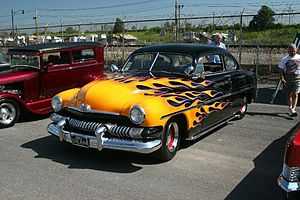Lead sled

Automotive usage
Originally, the lead sled referred to extensively repaired/modified cars due to the use of lead as body filler and was, for the most part, an insult.
Since the introduction of artificial fillers (such as Bondo), the term has come to mean a post-war, large (full size) American car of the 1950s.
A lead sled tends to have all extra side moldings shaved off and filled, with the suspension lowered. Lead sleds are built for style, not speed.
Among the first customized cars referred to as lead sleds were built by Harry Westergard in Sacramento, California. Westergard modified over a dozen cars ranging from a 1931 Model A Ford roadster to two 1947 Chevrolets. He used lead extensively to fill openings in doors, hoods and trunk lids and adapt front ends to accommodate grills from more expensive cars such as Buicks, LaSalle's and Packards and in the extension of front fenders. [Reference http://kustomrama.com/index.php?title=Harry_Westergard]
Some common [later year] lead sleds are the 1949 Mercury, 1949 Ford and the 1959 Cadillac.
Other usages
Aircraft nicknames - It has also been used as a nickname for a variety of US military aircraft, including the F3H Demon, F-84 Thunderjet, F-105 Thunderchief, and SR-71 Blackbird. In particular the planes tend to be large, heavy or very fast, despite this, the planes maneuverability is relatively poor.[1] F-105 in particular gained such a nickname during the Vietnam War. While the plane was fast in straight lines it was not very maneuverable and the missions it flew rendered it very vulnerable to enemy weapons and lost nearly half the fleet.
See also
References
- ↑ "Aircraft nicknames and designations". Aviation.ru. Retrieved 2011-11-20.
The Auto Channel - Car Speak-To-English Glossary of Terms